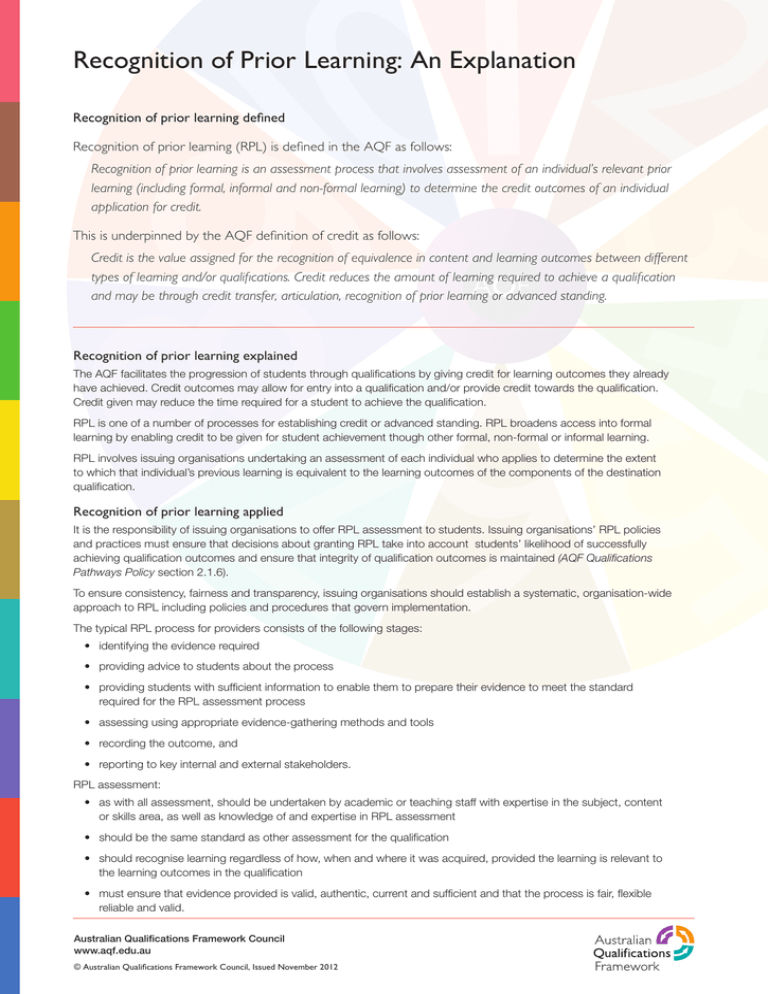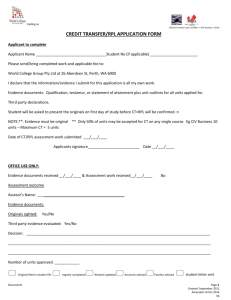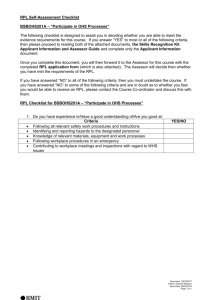Recognition of Prior Learning - Australian Qualifications Framework
advertisement

Recognition of Prior Learning: An Explanation Recognition of prior learning defined Recognition of prior learning (RPL) is defined in the AQF as follows: Recognition of prior learning is an assessment process that involves assessment of an individual’s relevant prior learning (including formal, informal and non-formal learning) to determine the credit outcomes of an individual application for credit. This is underpinned by the AQF definition of credit as follows: Credit is the value assigned for the recognition of equivalence in content and learning outcomes between different types of learning and/or qualifications. Credit reduces the amount of learning required to achieve a qualification and may be through credit transfer, articulation, recognition of prior learning or advanced standing. Recognition of prior learning explained The AQF facilitates the progression of students through qualifications by giving credit for learning outcomes they already have achieved. Credit outcomes may allow for entry into a qualification and/or provide credit towards the qualification. Credit given may reduce the time required for a student to achieve the qualification. RPL is one of a number of processes for establishing credit or advanced standing. RPL broadens access into formal learning by enabling credit to be given for student achievement though other formal, non-formal or informal learning. RPL involves issuing organisations undertaking an assessment of each individual who applies to determine the extent to which that individual’s previous learning is equivalent to the learning outcomes of the components of the destination qualification. Recognition of prior learning applied It is the responsibility of issuing organisations to offer RPL assessment to students. Issuing organisations’ RPL policies and practices must ensure that decisions about granting RPL take into account students’ likelihood of successfully achieving qualification outcomes and ensure that integrity of qualification outcomes is maintained (AQF Qualifications Pathways Policy section 2.1.6). To ensure consistency, fairness and transparency, issuing organisations should establish a systematic, organisation-wide approach to RPL including policies and procedures that govern implementation. The typical RPL process for providers consists of the following stages: • identifying the evidence required • providing advice to students about the process • p roviding students with sufficient information to enable them to prepare their evidence to meet the standard required for the RPL assessment process • assessing using appropriate evidence-gathering methods and tools • recording the outcome, and • reporting to key internal and external stakeholders. RPL assessment: • a s with all assessment, should be undertaken by academic or teaching staff with expertise in the subject, content or skills area, as well as knowledge of and expertise in RPL assessment • should be the same standard as other assessment for the qualification • s hould recognise learning regardless of how, when and where it was acquired, provided the learning is relevant to the learning outcomes in the qualification • m ust ensure that evidence provided is valid, authentic, current and sufficient and that the process is fair, flexible reliable and valid. Australian Qualifications Framework Council www.aqf.edu.au © Australian Qualifications Framework Council, Issued November 2012 Recognition of Prior Learning: An Explanation RPL assessment methods: • s hould include reasonable adjustment for the literacy levels, cultural background and experiences of students, and it should not be a proxy for the assessment of skills such as literacy except where these are intrinsic to the learning outcomes of the qualification component • s hould address the specific evidence required to demonstrate prior achievement of the learning outcomes and assessment requirements of the particular qualification components for which credit is sought • s hould provide a range of ways for individuals to demonstrate that they have met the required outcomes and can be granted credit. These might include: - mapping of learning outcomes from prior formal or non-formal learning to the relevant qualification components - questioning (oral or written) - observation of performance in work based and/or simulated environments - challenge examinations/assessments - c onsideration of third party reports and/or other documentation such as articles, reports, project material, papers, testimonials or other products prepared by the RPL applicant that relate to the learning outcomes of the relevant qualification component -consideration of a portfolio and review of contents, and -participation in structured assessment activities that individuals normally would be required to undertake if they were enrolled in the qualification components. The assessment outcomes may enable the student to meet the entry requirements and/or components of the qualification. This may reduce the duration of the qualification. The agreed credit outcomes of the assessment of previous learning through RPL are specific to the individual. They may establish a precedent which can be used for other RPL assessments and potentially form the basis for future credit transfer agreements. See also AQF explanation on volume of learning AQF explanation on credit transfer AQF explanation on articulation © Australian Qualifications Framework Council, Issued November 2012 2

